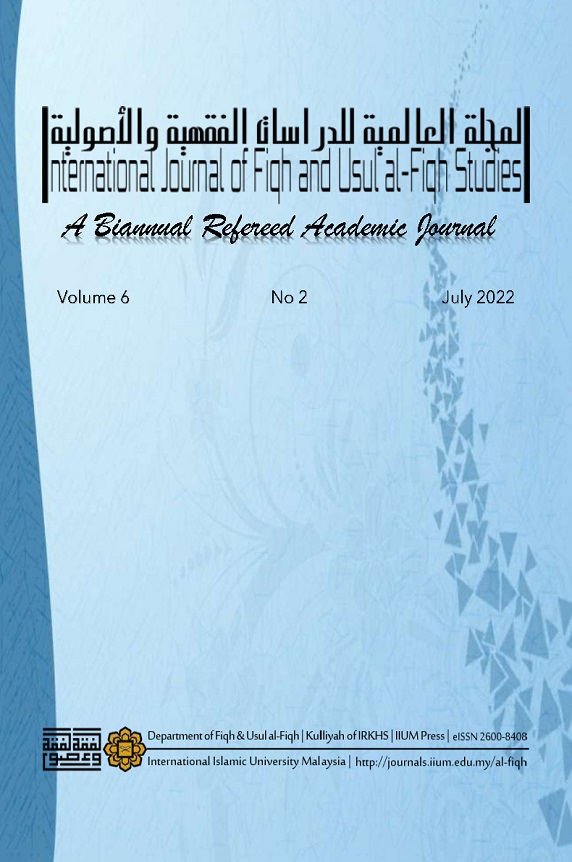The Concept of the Child in Islamic law, International Covenants and Nigerian Law: A Comparative Study
مفهوم الطفل في الشريعة الإسلامية والمواثيق الدولية والقانون النيجيري: دراسة مقارنة
DOI:
https://doi.org/10.31436/ijfus.v6i2.262Keywords:
Child, Islamic law, International law, Nigeria lawAbstract
This research deals with the concept of the child in Islamic law, international covenants and Nigerian law, and the consequent matters. So, the research presents the concept of the child from these three perspectives in order to compare them and determine the places of the agreement and disagreement, and what should be considered and what deserves a response for violating the principles of Islam. The research depends on the qualitative approach for collecting information from its original sources, then studying and analyzing it. The results of the research show that comparing the age of maturity or the end of childhood - as stated in international covenants and Nigerian law - with the concept of puberty in Islam shows its contradiction with Islamic principles. This is because the age of maturity is often understood before the age of eighteen. If this age is considered a dividing line between childhood and adulthood, then this leads to omit many religious responsibilities. This is because a child becomes legally responsible for performing all acts of worship and responsible for all shortcomings from the time he reaches puberty, which often occurs before the age of eighteen. Therefore, the time of puberty set by the Lawgiver (Allah SWT) must be considered, especially in the obligations of legal responsibility. But if we stipulate the child’s entitlement to exercise some social rights at the age of 18 years, there is no problem with that in the eyes of Islam as long as there is public interest in it.
Downloads
Metrics
References
ʾAbū Dāwūd, Sulaymān Bin al-ʾAshʿath al-Sijistānī. n.d. Sunan ʾAbī Dāwūd. Bayrūt: al-Maktabah al-ʿAṣriyyah.
al-ʿAẓīm ʾAbādī, Muḥammad ʾAshraf Bin ʾAmīr. 1415AH. ʿAwn al-Maʿbūd. Bayrūt: Dār al-Kutub al-ʿIlmiyyah.
al-Baghawī, Muḥyī al-Sunnah ʾAbū Muḥammad. 1997. Tafsīr al-Baghāwī. Dār Ṭayyibah Li al-Nashr Wa al-Tawzīʿ.
al-Bukhārī, Muḥammad Bin ʾIsmāʿīl. 1422AH. Ṣaḥīḥ al-Bukhārī. Dār Ṭawq al-Najāt.
al-Dārquṭnī, ʾAbū al-Ḥasan ʿAlī Bin ʿUmar. 2004. Sunan al-Dārquṭnī. Bayrūt: Muʾassasah al-Risālah.
al-Dīnawrī, ʾAbū Bakr ʾAḥmab Bin Marwan. 1419AH. aL-Mujālasah Wa Jawāhir al-ʿIlm. al-Baḥrayn: Jamʿiyyah al-Tarbiyyah al-ʾIslāmiyyah.
al-Farābī, ʾAbū Naṣr ʾIsmāʿīl Bin Ḥammād. 1987. al-Ṣiḥāḥ Tāj al-Lughah. Bayrūt: Dār al-ʿIlm Li al-Malāyyīn.
al-Ḥākim, ʾʾAbū ʿAbdullāh Muḥammad Bin ʿAbdullāh. 1990. al-Mustadrak ʿAlā al-Ṣaḥīḥayn. Bayrūt: Dār al-Kutub al-ʿIlmiyyah.
al-Nawawī, ʾAbū Zakariyyā. 1392AH al-Minhāj Sharḥ Ṣaḥīḥ Muslim. Dār ʾIḥyāʾ al-Turāth al-ʿArabī.
al-Qurṭubī, ʾAbū ʿAbdullāh Muḥammad Bin ʾAḥmad. 1964. al-Jāmiʿ Li ʾAḥkām al-Qurʾān. al-Qāhirah: Dār al-Kutub al-Miṣriyyah.
al-Shawkānī, Muḥammad Bin ʿAlī. 1414 AH. Fatḥ al-Qadīr. Dimashq: Dār ʾIbn Kathīr.
al-Tirmidhī, ʾAbū ʿῙsā Muḥammad Bin ʿῙsā. 1975. Sunan al-Tirmidhī. Miṣr: Muṣṭafā al-Bābī al-Ḥalabī.
Assim, Usang Maria. (25-09-2020). "Why the Child’s Rights Act Still Doesn’t Apply Throughout Nigeria". The Conversation.
Federal Ministry of Health. 2014. Guidelines for Young Persons’ Participation in Research and Access to Sexual and Reproductive Health Services in Nigeria. https://www.popcouncil.org/uploads/pdfs/2014HIV_YoungPersonsSRH-Nigeria.pdf
ʾIbn Ḥajar, ʾAḥmad Bin ʿAlī al-ʿAsqalānī. 1379AH. Fatḥ al-Bārī. Bayrūt: Dār al- Maʿrīfah.
ʾIbn Ḥibbān, ʾAbū Ḥātim. 1993. Ṣaḥīḥ ʾIbn Ḥibbān. Bayrūt: Muʾassasah al-Risālah.
ʾIbn Kathīr, ʾAbū al-Fidāʾ ʾIsmāʿīl Bin ‘Umar. 1420AH. Tafsīr al-Qurʾān al-ʿAẓīm. Dār Ṭayyibah Li al-Nashr Wa al-Tawzīʿ.
ʾIbn Manẓūr, Jamāl al-Dīn. 1414AH. Lisān al-ʿArab. Bayrūt: Dār Ṣādir.
Muslim Bin Ḥajjāj. n.d. Ṣaḥiḥ Muslim. Bayrūt: Dār ʾIḥyāʾ al-Turāth al-ʿArabī.
Nigeria, Matrimonial Causes Act in Nigeria. https://lawsofnigeria.placng.org/laws/M7.pdf.
Nigeria. Child’s Right Act in Nigeria, 2003. https://www.refworld.org/pdfid/5568201f4.pdf.
Nigeria. Nigerian Criminal Code Act. https://lawsofnigeria.placng.org/laws/C38.pdf.
Nigeria. Nigerian Labour Act 2010. https://lawsofnigeria.placng.org/laws/L1.pdf.
Nigeria. Penal Code (Northern States) Federal Provisions Act. https://policehumanrightsresources.org/content/uploads/2016/07/Penal-Code-Northern-StatesFederal-Provisions-Act-1960.pdf?x96812.
Nike Adebowale. (05-11-2019). “11 states in northern Nigeria yet to pass child rights law”. Premium Times.
Nwachuku, M. A. Aja. 2016. “A Legal Analysis of the Nebulous Concept of Childhood in Nigeria”. Scientific Research An Academic Publisher. Vol. 7, No. 2.
Sila, Akinwumi Olayinka. 2010. "Legal Impediments on the Practical Implementation of the Child Right Act 2003". International Journal of Legal Information. Vol. 37, Issue. 3.
The Guardian. (06-07-2018). “The Nigerian Child and National Policies”. The Guardian.
UNICEF. 2007. Implementation Handbook for the Convention on The Rights of the Child. United Nations Publications.
United Nation. 1989. United Nation Convention on the rights of the child 1989. https://www.cypcs.org.uk/ufiles/UNCRC-Pocketbook.pdf
Zayn al-Dīn, ʾAbū ʿAbdullāh Muḥammad Bin ʾAbū Bakr. 1999. Mukhtar al-Ṣiḥāḥ. Bayrūt: al-Maktabah al-ʿAṣriyyah.
Downloads
Published
How to Cite
Issue
Section
License

This work is licensed under a Creative Commons Attribution-NonCommercial 4.0 International License.
The IIUM journal follows the open access policy.
Consent to publish: The Author(s) agree to publish their articles with IIUM Press.
Declaration: The Author(s) declare that the article has not been published before in any form and that it is not concurrently submitted to another publication, and also that it does not infringe on anyone’s copyright. The Author(s) holds the IIUM Press and Editors of the journal harmless against all copyright claims.
Transfer of copyright: The Author(s) hereby agree to transfer the copyright of the article to IIUM Press, which shall have the exclusive and unlimited right to publish the article in any form, including in electronic media. However, the Author(s) will reserve the right to reproduce the article for educational and scientific purposes provided that the written consent of the Publisher is obtained. For the article with more than one author, the corresponding author confirms that he/she is authorized by his/her co-author(s) to grant this transfer of copyright.



















